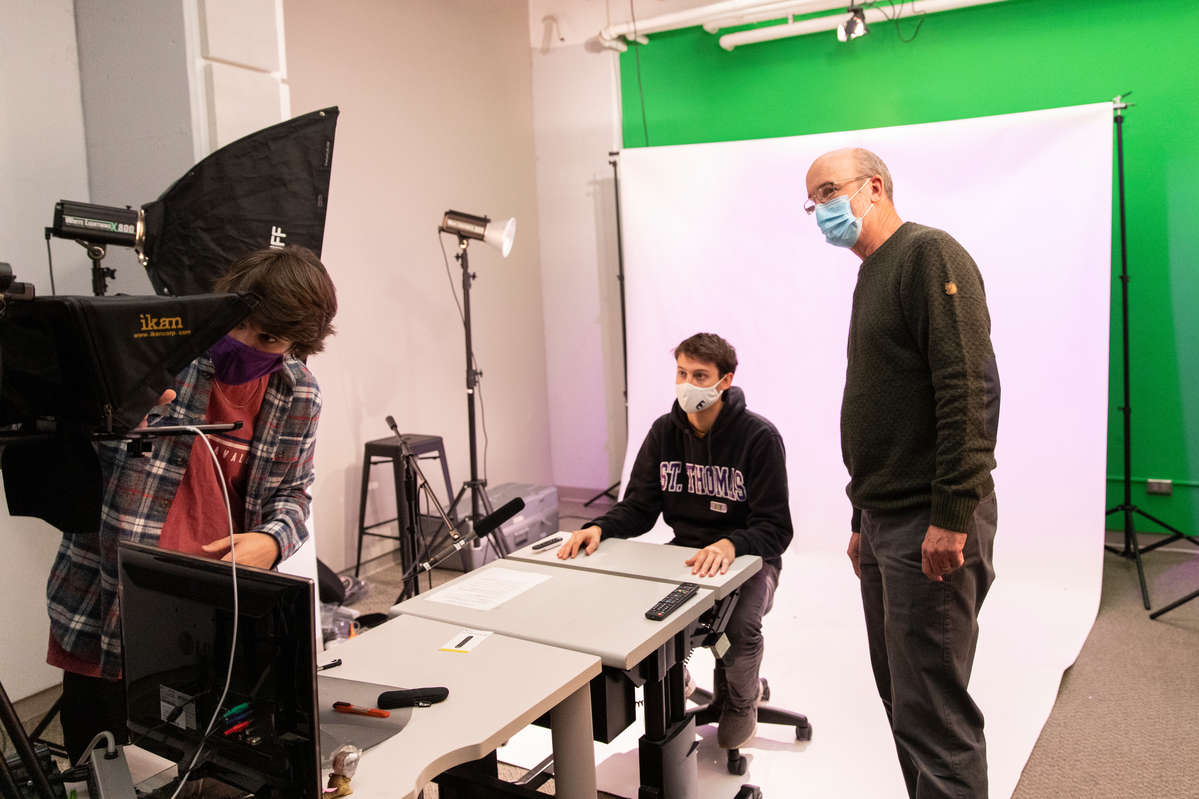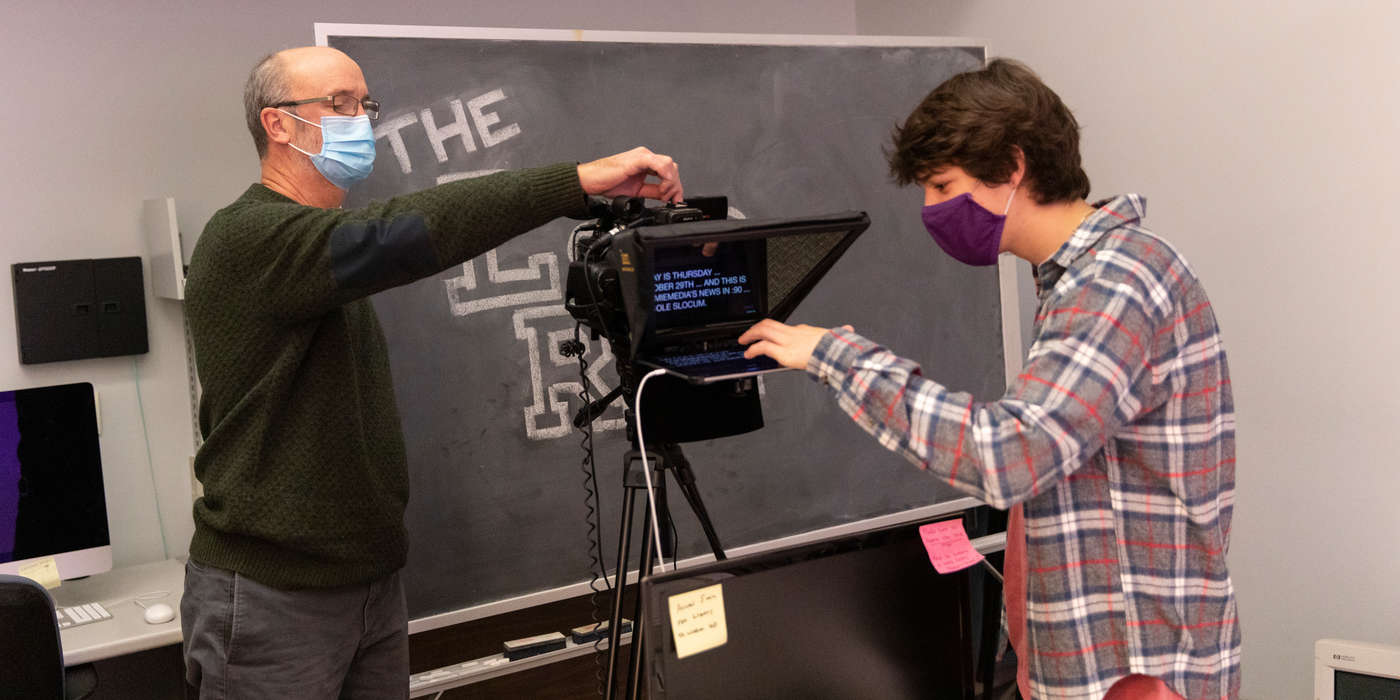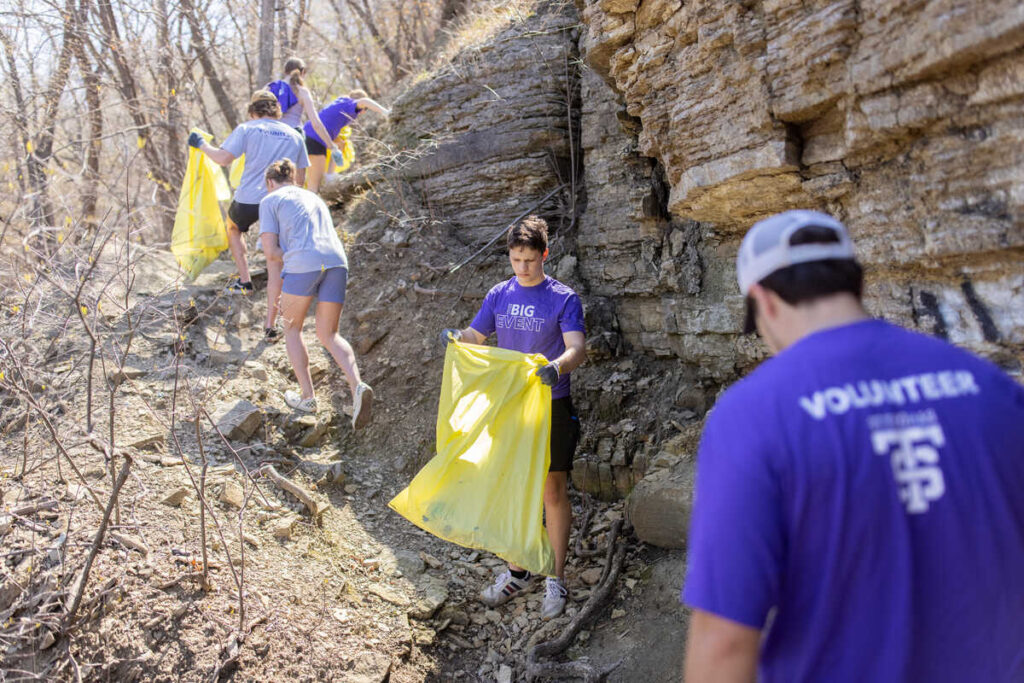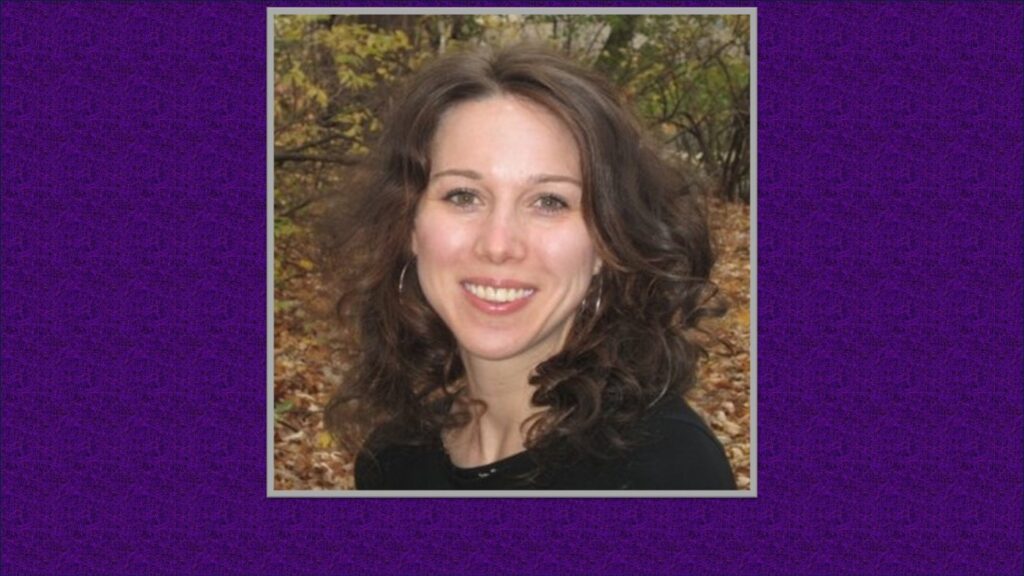In response to a rapidly changing media landscape, St. Thomas created the Department of Emerging Media last year. Housed in the College of Arts and Sciences, Emerging Media features three tracks – journalism, strategic communication and digital media arts – and includes TommieMedia, KUST Radio, ThreeSixty Journalism and an affiliation with the UnderTold Stories Project.
Professor and Department Chair Mark Neuzil said students pursuing a career in mass communications not only have to know how to tell a good story, they have to be able to do it through a myriad of ways including audio, video, print, web and photos.

Journalism Professor Mark Neuzil, far right, works with students Scout Mason, left, and Joey Swanson, middle, in the TommieMedia studio.
For example, the web-based student organization TommieMedia is an ideal training ground for teaching students how to deliver the news – from local to national – through high-quality, timely multiplatform pieces, as well as create strategic campaigns, infographics and new web designs.
"We want to be ahead of the game – in some ways we can use TommieMedia for this,” Neuzil said when it comes to training future media minds. “We can experiment with things that other media outlets would never do because they have to make money and we don’t. We don’t know if everything is going to work or not, but we’ll try. And if it doesn’t, we can throw it away. If it works, we can incorporate it.”
Because the Twin Cities is ripe with TV stations, print media outlets, radio stations, in-house corporate public relations and strategic communication agencies, there are many opportunities for internships. Neuzil said a majority of students have at least one internship before they graduate.
The Newsroom talked with Neuzil about the Emerging Media program, including his thoughts on the future of journalism, skills needed to succeed in the profession today and how students have changed over the years.
How is St. Thomas preparing students to respond to a rapidly changing media environment?
We want our students to be critical thinkers. That’s the beauty of a liberal arts education. But we have to teach technology; it's unavoidable. With that technology piece students must understand what makes a good story and how to tell a good story. Sometimes, for example, a story lends itself to a particular medium. Sometimes the medium changes. Social media forms change rapidly. We want students to be able to tell a story or produce a campaign with all types of technology by the time they graduate – through text, a photo slideshow, a video package story. They should have all those basic skills to be able to use those platforms for their stories. That also makes them more employable.
In a rapidly changing environment, if you've got people at your company who don’t know how to write web copy or aren’t familiar with HTML or can't shoot and edit a video, we can supply you with students who can do all those things. And it starts with them being critical thinkers, curious and nimble. A mom and her high school-aged son came in recently and asked me what the most important skill her son would learn with us. I said our hope is that he becomes a lifelong learner.
What are the challenges of teaching emerging media classes in a pandemic?
First, I worry about the mental and physical health of our students, staff and faculty. The stress is real and it is daily. We need to take care of each other.
A concrete pandemic challenge has to do with our equipment and needing to be in person to be able to show someone how to use it. You can't really teach a TV studio class without being in the studio. We are really challenged with rotating the proper number of students in because the space is too small to get everybody in there at once. You have to have people come on certain days – it's a trade-off.
There’s also the challenge of keeping the equipment clean. You've got to make sure everything is disinfected because it may have multiple users in a day. We received a small grant from one of the federal programs to buy our students a personal headset. I couldn't think of a better way to transmit the virus than people sharing headsets, so now they each have their own.
The pandemic is one big exercise in problem-solving.
How are the students different today than they’ve been in the past?

Professor Mark Neuzil
National trends are in our favor. They’re more interested in news than the previous generation. We had a generation of students for a while who were less interested in the news of the day. That has changed dramatically in the last three or four years, not just at St. Thomas. There was a similar phenomenon where people became interested in being journalists after the Watergate scandal. At that time, it seemed like a romantic and important job. We're seeing a revival in that with the numbers going up steadily. After Watergate, it lasted for quite some time. We’re not sure how long it’ll last this time.
The main difference between the Watergate kids – of which I was one – and kids today is that these students are coming at it with more of a point of view. Rather than being a blank slate in terms of political persuasion, students now come in with stronger political viewpoints. They have a desire to do things like documentaries that have a point of view. We need to be able to adjust to that, which is why our digital media arts program is so important.
What is the benefit of having ThreeSixty Journalism – a high school journalism program training a diverse group of future communicators – at St. Thomas?
It’s a huge asset for us because it trains high school kids to be journalists and then they get exposed to St. Thomas. In normal years, they work throughout our campus and become comfortable here. We give scholarships to the best of them and they really enrich our program dramatically. If I were to list the student leaders who came out of ThreeSixty, it would be a long list. They bring diversity into the newsrooms and many of them are now working in the Twin Cities, the Midwest and even across the country in media jobs. The program helps them get involved in the political process and the media social system at an early age. Through the program, they are trained in storytelling, interviewing, researching and how to use media equipment – cameras, microphones, light kits.
You oversee TommieMedia, which features news reported daily by a team of 70 students and advisers. Tell me about the compelling “heroes” piece students put together in October. It featured the story of a professor who had a medical emergency on campus.
Our student-journalists did a tremendous job with that story. One of the challenges on that story was how to illustrate it. We didn’t want to do it by Zoom and show just another square head. We decided to see if we could get each of the rescuers to pose for a portrait picture at the scene.
Of course, we had to find out who the rescuers were, so I asked a whole bunch of students to help find them. Within four or five days we had almost everybody.
Professor Pam Schmid and I organized the story structure and then helped the students set it up. I used John Hersey’s Hiroshima book as a model for the individual stories. I also talked to the family [of the professor] several times to make sure he was OK and to keep tabs.
I think the 'heroes' story, as we call it, is one of the best pieces of multimedia journalism we have produced in 12 years of TommieMedia. And one of the reasons it was so gratifying is that it was a team effort – not just the bylines on the story, but the advisers and student editors in the back of the house making it sing. That story could have been published on any news website in the country.
What excites you about the future of emerging media?
The storytelling avenues. We’ve hardly scratched the surface as to how to use some of these tools in an effective way. We’ve seen some good stories in documentary formats or in social media formats, but I think we've only begun on how we can use them and incorporate them into the storytelling that we do.
We have a tremendous faculty, very talented. Our three new faculty hires, April Eichmeier, Yayu Feng and Sky Anderson, bring energy and fresh ideas – such as adding a class on gaming and game design – to the team. Some days I think the best action I can take is to stay out of the way.







